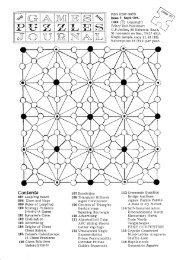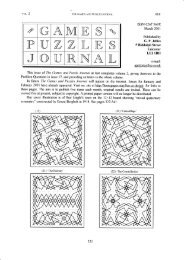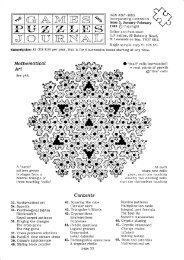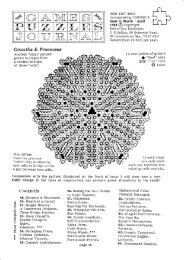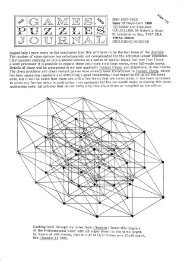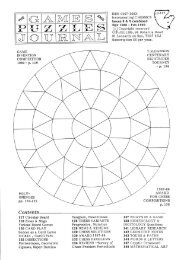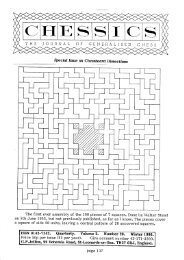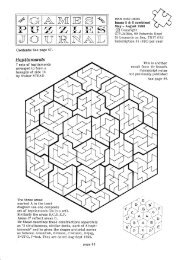The Games and Puzzles Journal, #15 - Mayhematics
The Games and Puzzles Journal, #15 - Mayhematics
The Games and Puzzles Journal, #15 - Mayhematics
You also want an ePaper? Increase the reach of your titles
YUMPU automatically turns print PDFs into web optimized ePapers that Google loves.
o<br />
THE GAh.{ES AND PLTZZLES JOLTRNAL<br />
13. <strong>The</strong> Rarning oI Rumbers<br />
<strong>The</strong> first trvo numbers rvith the same<br />
name are 37 :36 + I - (tetekekli <strong>and</strong> 38 : Zxlg<br />
- z*(18+l) - te(tskeki). To avoid this ambiguiry<br />
we can introduce another letter, say l, to mark the<br />
beginning of the bracket to which the i adds a<br />
unit, except when the i affects the whole. (<strong>The</strong> use<br />
of 'l' is an improvement on using trvo 'i's as l\,'as<br />
suggested in the problem statement.) Thus 37<br />
tetekeki <strong>and</strong> 38 : teltekeki.<br />
<strong>The</strong> first number whose name is altered<br />
by this notation is 22 - teltent 2x(2"5 + I ), then<br />
23 : teltenii is the first ending with tr,lo 'i's.<br />
If we take the 'nurnber of the beast' to be<br />
666 it is equal to 2x3x3x37 _ tekekeltetekeki,<br />
n'hich is a name to rival Rumpelstiltskin!<br />
Further on this topic in problem 19.<br />
7t*. eodrarian eurpeney<br />
Professor Cranium corrects qr' fantasy<br />
geography by pointing out that the country<br />
borderlng Contraria should be Raritania, <strong>and</strong> not<br />
Ruritania which is a quite different place, but this<br />
does not affect the numerical problem.<br />
If a Raritanian dollar is worth s clonks<br />
plus b clinks <strong>and</strong> there are r clinks in a clonk then<br />
IRD<br />
given a*bx clinks, <strong>and</strong> it is implied that this<br />
equals Z{b+ax), that is (r-2)b : (lx-l}a.We also<br />
have the conditions 0 1 a<br />
solntions for (a,b,x\ are: (0, I ,2r, (1,3,5), (2,5,8),<br />
{3,7,1 U, {4,9,14), {5,1 L,l7), (6,13,2A}, (7,15,23},<br />
<strong>The</strong>se are found by taking successive values<br />
for x) e.g. for r<br />
divides through by 3 giving 3b<br />
satisfied by a - 3, b : 7 ,less than I 1, as required.<br />
On the second occasion lRD - d+cx <strong>and</strong><br />
the traveller receives c*dx which equals 3{d+c4<br />
so (x-3)d - (3r-1)c r,r,tth 0<br />
smallest solutions for {c,d,r) are: (0, 1,3), {0,2,3),<br />
( 1,5 ,7), ( 1,4, l l ), (2,9, l l ), (3, 1 1., 15), (2,7 ,19),<br />
(4, 1 4,lg)., (5,17,23r,<br />
So the fewest number of clinks in a clonk<br />
is 11" <strong>The</strong> nert higher solution is 23.<br />
15. ffiystic Rectangles<br />
It is a general rule that if the entries in an<br />
affay rxs are anv rxs numbers in arithmetical<br />
progression a, a*b, a*Zb, ..., a+(rs-l)b, then<br />
constant ro\,v <strong>and</strong> column sums (i.e. magic<br />
rectangles) are possible only when r <strong>and</strong> s are<br />
both even or both odd. <strong>The</strong> reason for this is that<br />
the total T of all the entries is rsa + rs(rs- l)blz<br />
<strong>and</strong> if rs-l is odd then for the row <strong>and</strong> column<br />
sums Tlr <strong>and</strong> T/s to be whole numbers both r <strong>and</strong><br />
s must be divisible by 2 (i,e. even). On the other<br />
h<strong>and</strong> if rs-l is even then rs is odd, which implies<br />
that both r <strong>and</strong> s are odd.<br />
Although magic odd*even rectangles are<br />
not possible, we can consider 'mystic' rectangles<br />
in which the rolv <strong>and</strong> column sums are all<br />
multiples of the same constant (preferably the<br />
largest possible constant).<br />
This question, for the 3 x4 case, formed<br />
part of an unpublished article that I wrote for <strong>The</strong><br />
Dozenal <strong>Journal</strong>, but following the death of its<br />
editor, Don Hammond, no issue has appeared<br />
since 1992. <strong>The</strong> back page of some issues carried<br />
a 3 x4 array of the rz dazenal digits, as they *ight<br />
appsar on a telephone button pad or calculator.<br />
<strong>The</strong> slmbols proposed for digits ten <strong>and</strong><br />
eleven by the Dozenal Society' of Great Britain are<br />
an inverted 7 <strong>and</strong> 3, while the US Society<br />
advocates a crossed X <strong>and</strong> the hatch symbol #.<br />
Three of these s5.mbols not being readily available<br />
even on modern word processors does not help<br />
their cause. I find it sonvenient to use A for l0<br />
<strong>and</strong> B for t l. (This conforms to the notv<br />
established notation used in computing for base<br />
16. digits 0. ..., 9, A, ..., F; & notation that<br />
provides for all cases up to base Z - 35.)<br />
For a 3 x4 array of dozenal digits the<br />
mystic constant is eleven. <strong>The</strong> follorvlng are all<br />
the 'basic' mystic affays (in r,vhich 0 is at the top<br />
left corner <strong>and</strong> the other elements in the first row<br />
<strong>and</strong> column are affanged in order of magnitude).<br />
In all the arrays trvo columns sum to l l<br />
<strong>and</strong> two sum ta 22. <strong>The</strong>re are 14 arravs in u'hich<br />
the three rows sum to 22:<br />
O1AB O1-AB O29B O3BB O3BB O39A<br />
2'785 5782 435A 4A26 5917 425F.<br />
9346 6349 7681 7915 6A24 7681<br />
039A 04BA 0568 0568 057A 057A<br />
5728 5?19 1498 327A 2B1B 3268<br />
5184 6F23 p,21 3 8491 9634 8491<br />
0589 0589<br />
1486 462A<br />
A23] 7813<br />
270




